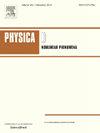A study of the reconnection of antiparallel vortices in the infinitely thin case and in the finite thickness case
IF 2.7
3区 数学
Q1 MATHEMATICS, APPLIED
引用次数: 0
Abstract
The reconnection of vortices is an important example of the transition from laminar to turbulent flow. The simplest case is the reconnection of a pair of antiparallel line vortices. At first, they undergo long wave deformation (Crow waves), and then reconnect to form coherent structures. Although the behavior of the vortices before and after the reconnection can be clearly observed, what happens during the reconnection still needs to be explained. In fact, due to the finite thickness of the vortices, it is possible to distinguish different types of reconnection, such as reconnection of vorticity lines or reconnection of isosurfaces of vorticity magnitude. This makes unclear the definition of the reconnection time and reconnection point, which represents one major challenge. Note that the smallest scale of emerged coherent structures also depends on this thickness. In this paper, we consider an infinitely thin vortex approximation to study the vorticity reconnection process. We show that, in this case, the behavior after the reconnection is quasi-periodic, with the quasi-period being independent of the angle between the vortices. We observe a similarity between the behavior of the vortices in the reconnection region and the evolution of a corner of a polygonal vortex under the localized induction approximation, which may be considered as an indicator that the vortices form a corner at the reconnection. At the end, we compare the results with a solution of the Navier–Stokes equations for the reconnection of a pair of antiparallel vortices with finite thickness, where the pressure isosurfaces are used to visualize the reconnection process. We also use the fluid impulse to define the reconnection time, the reconnection point, and the quasi-period for this case.
无限薄和有限厚情况下反平行涡旋重连的研究
涡旋的重新连接是层流向湍流过渡的一个重要例子。最简单的例子是一对反平行线涡旋的重新连接。首先,它们经历长波变形(克罗波),然后重新连接形成连贯的结构。虽然可以清楚地观察到重联前后的涡的行为,但是在重联过程中发生了什么还需要解释。事实上,由于涡的厚度有限,可以区分不同类型的重连,如涡度线重连或涡度大小的等值面重连。这使得重新连接时间和重新连接点的定义不明确,这是一个主要的挑战。请注意,出现的最小规模的连贯结构也取决于这个厚度。本文考虑一个无限薄涡近似来研究涡度重联过程。我们证明,在这种情况下,重新连接后的行为是准周期的,准周期与涡旋之间的角度无关。我们观察到,在局部感应近似下,重连接区域内的涡的行为与多边形涡的一个角的演变有相似之处,这可以认为是在重连接区域内涡形成了一个角的标志。最后,我们将结果与Navier-Stokes方程的解进行了比较,该解用于对具有有限厚度的反平行涡旋的重连,其中压力等面用于可视化重连过程。我们还使用流体冲量来定义这种情况下的重连时间、重连点和准周期。
本文章由计算机程序翻译,如有差异,请以英文原文为准。
求助全文
约1分钟内获得全文
求助全文
来源期刊

Physica D: Nonlinear Phenomena
物理-物理:数学物理
CiteScore
7.30
自引率
7.50%
发文量
213
审稿时长
65 days
期刊介绍:
Physica D (Nonlinear Phenomena) publishes research and review articles reporting on experimental and theoretical works, techniques and ideas that advance the understanding of nonlinear phenomena. Topics encompass wave motion in physical, chemical and biological systems; physical or biological phenomena governed by nonlinear field equations, including hydrodynamics and turbulence; pattern formation and cooperative phenomena; instability, bifurcations, chaos, and space-time disorder; integrable/Hamiltonian systems; asymptotic analysis and, more generally, mathematical methods for nonlinear systems.
 求助内容:
求助内容: 应助结果提醒方式:
应助结果提醒方式:


